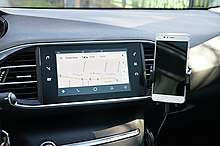Android Auto
|
| |
 | |
| Original author(s) | |
|---|---|
| Developer(s) | |
| Initial release | March 19, 2015 |
| Operating system | Android 5.0+ ("Lollipop") |
| Type | Telematics |
| License | Proprietary |
| Website |
www |
Android Auto (stylised androidauto) is a mobile app developed by Google to mirror features from an Android device (e.g., smartphone) to a car's compatible in-dash information and entertainment head unit or to a dashcam.
Once an Android device is paired with the head unit, the system mirrors qualified apps from the device to the vehicle's display, with a simple, driver-friendly user interface. Supported apps include GPS mapping/navigation, music playback, SMS, telephone, and web search. The system supports both touchscreen and button-controlled head unit displays, although hands-free operation through voice commands is encouraged to minimize driving distraction. Android Auto debuted at Google I/O 2014, and the app was released on 19 March 2015. Android Auto is part of the Open Automotive Alliance announced in 2014, and is a joint effort between 28 automobile manufacturers, with Nvidia as tech supplier. It is available in 28 countries.
Functionality

The most common way Android Auto is deployed is via an Android mobile device running the Android Auto app, acting as a master to a vehicle's dashboard head unit that supports this functionality.[1] Once the user's Android device is connected to the vehicle, the head unit will serve as an external display for the Android device, presenting supported software in a car-specific user interface provided by the Android Auto app.[1][2] In Android Auto's first iterations, the device was required to be connected via USB to the car.[3]
Alternatively, in November 2016, Google added the option to run Android Auto as a regular app on an Android device, i.e., not tethered to a car's head unit, which allows it to be used on Android-powered head units, or simply on a personal phone or tablet in the vehicle.[4] In addition, on January 1, 2018, it was announced that JVCKenwood would be exhibiting wireless Android Auto-enabled head units at CES 2018, which would be capable of operating without the need for a wired connection.[5]
Availability

Android Auto is as of August 2018 available in 28 countries.[6] The availability of apps on the system varies.
App support
An Android Auto SDK has been released, allowing third parties to modify their apps to work with Android Auto;[2] initially, only APIs for music and messaging apps would be available,[7][8] but it is expected that through Android Auto, the mobile device will have access to several of the automobile's sensors and inputs, such as GPS and high-quality GPS antennas, steering-wheel mounted buttons, the sound system, directional speakers, directional microphones, wheel speed, compass, mobile antennas, etc. Also, there is partial access to car data, a feature still under development.[9]
At CES 2018, Google confirmed that the Google Assistant would be coming to Android Auto later in the year.[10]
Currently supported apps include:
GPS navigation
Music
- Amazon Music
- Audible
- BBC iPlayer Radio
- Deezer
- doubleTwist
- Google Play Music
- iHeartRadio
- MediaMonkey
- Radioplayer
- Rocket Music Player
- Slacker
- Songza
- Spotify
- Stitcher
- TuneIn
Telephony/Messaging
Podcasts/Podcatchers
- CastBox
- Podcast Addict
- Pocket Cast
Head unit support
In May 2015, Hyundai became the first manufacturer to offer Android Auto support, making it available first in the 2015 Hyundai Sonata.[11] Automobile manufacturers that will offer Android Auto support in their cars include Abarth, Acura, Alfa Romeo, Audi, Bentley, Buick, Cadillac, Chevrolet, Chrysler, Dodge, Fiat, Ford, GMC, Honda, Hyundai, Infiniti, Jaguar Land Rover, Jeep, Kia, Lamborghini, Lexus, Lincoln, Mahindra and Mahindra, Maserati, Mazda, Mercedes-Benz, Mitsubishi, Nissan, Opel, Peugeot, RAM, Renault, SEAT, Škoda, SsangYong, Subaru, Suzuki, Tata Motors Cars, Volkswagen and Volvo.[12]
Additionally, aftermarket car-audio systems supporting Android Auto add the technology into host vehicles, including Pioneer,[13] Kenwood,[14] Panasonic,[15] and Sony.[16]
See also
References
- 1 2 Devine, Richard (June 26, 2014). "What you need to know about Android Auto". Android Central. Retrieved June 27, 2014.
- 1 2 Goodwin, Antuan (June 25, 2014). "Google's new Android Auto is like Google Now for your car". CNET. CBS Interactive. Retrieved June 26, 2014.
- ↑ Gorman, Michael (June 25, 2014). "Google gives us a simulated ride with Android Auto". Engadget. AOL Inc. Retrieved June 26, 2014.
- ↑ "Android Auto: now available in every car". Official Google Blog. 2016-11-07.
- ↑ "JVCKENWOOD will have a pair of wireless Android Auto-capable head units on display at CES". WCCFTech. 2018-01-01.
- ↑ "FAQ". Android. Retrieved 1 August 2018.
- ↑ Moynihan, Tim (June 25, 2014). "Google Announces Android Auto, Its Answer to Apple's CarPlay". Wired. Condé Nast. Retrieved June 26, 2014.
- ↑ "Autoradio GPS". Archived from the original on March 17, 2016. Retrieved March 17, 2016.
- ↑ Brenner, Andy (June 27, 2014). "Google I/O 2014 - Android Auto: Developers, Start Your Engines!". YouTube. Google. Retrieved July 5, 2014.
- ↑ Reigh, Brian (8 January 2018). "Google Assistant will soon live inside your car". Android Authority. Retrieved 10 January 2018.
- ↑ "Android Auto: The First Great In-Car Infotainment System". WIRED. Retrieved 2017-11-10.
- ↑ https://www.android.com/auto/
- ↑ "Pioneer-Android-Auto". Retrieved 28 August 2015.
- ↑ "Kenwood-Android-Auto". Retrieved January 4, 2016.
- ↑ "Android Auto for Panasonic". Android. Retrieved 2016-11-17.
- ↑ "Android Auto for Sony". Retrieved 2017-07-25.
External links
| Wikimedia Commons has media related to Android Auto. |
- Official website
- Android Auto app at the Play Store
